trailer PONTIAC GRAND-PRIX 1993 Owners Manual
[x] Cancel search | Manufacturer: PONTIAC, Model Year: 1993, Model line: GRAND-PRIX, Model: PONTIAC GRAND-PRIX 1993Pages: 338, PDF Size: 17.3 MB
Page 59 of 338
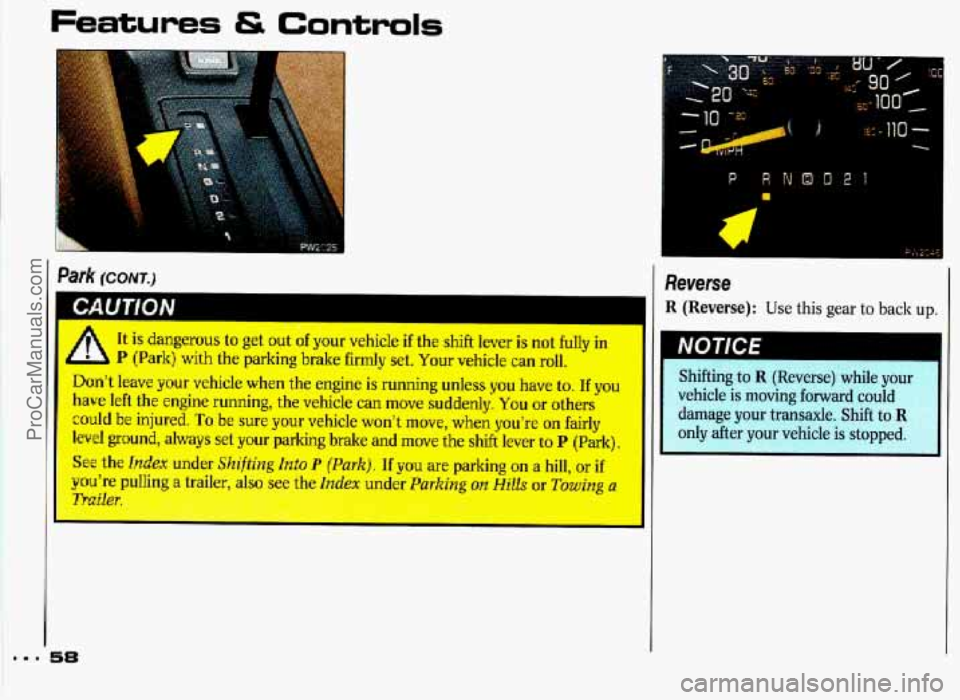
Features & Controls
. ;. -c
I
It is dangerous to get out of your vehicle if the shift lever is not fully in
h P {Park} with the parking brake firmly set. Your vehicle can roll.
Don’t leave your vehicle when the engine
is running unless you have to. If you
h,ave left the engine running, the vehicle can move suddenly. You or others
could
be injured. To be sure your vehicle won’t move, when you’re on fairly
level ground, always set your parking brake and move the shift lever to P (Park).
See th’e Index under Shifting Into P (Park). If you are parking on a hill, or if
you’re pulling a trailer, also e Index under Parking ~yt Hills or Towing a
[ep-:~:2>;gz%r-#p A,,2L:z:- d: . .--- - +-
Reverse
R (Reverse): Use this gear to back up.
Shifting to
R (Reverse)
vehicle is moving forward could damage your transaxle. Shift to
R
only after your vehicle is stopped.
ProCarManuals.com
Page 61 of 338
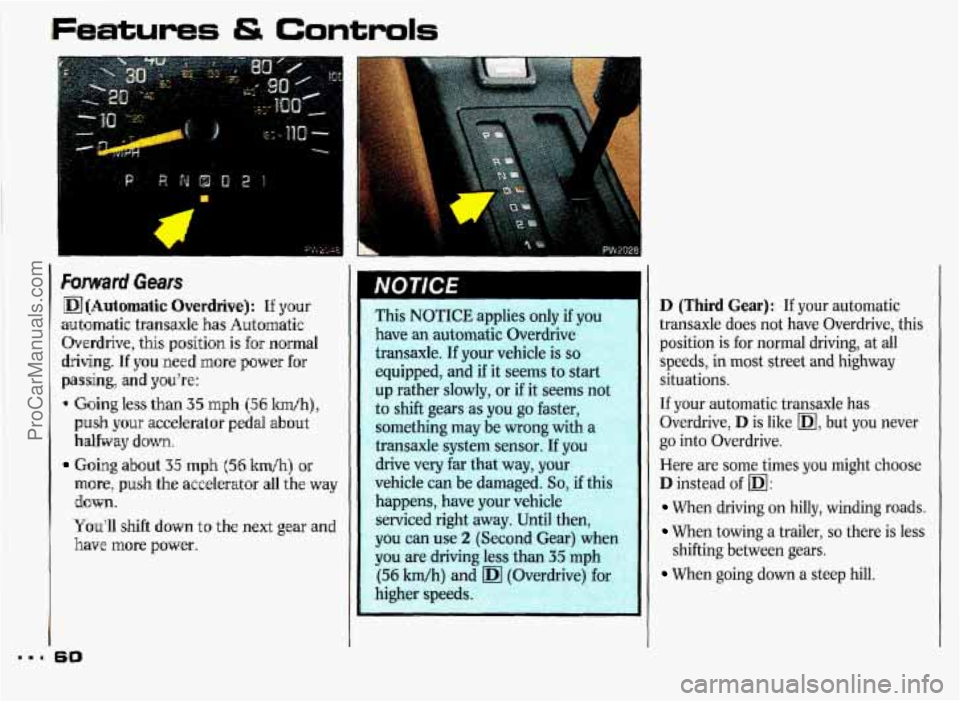
Farward Gears
mtdutornatic Overdrive): If your
autcmatic transaxle
has Automatic
Overdrive,
this position is for norma
&ivin,g. If you med more power for
pas.sing, and you're:
* Goling less than 35 mph (56 lmh) ,
push your accelerator pedal about
halfway
down.
Going about 35 mph [56 Wh) or
more, push the accelerator all the way
clhwn.
You'll shift down to the next gear and
have more power.
D (Third Gear): If your automatic
transaxle does not have Overdrive, this
position is for normal driving, at all
speeds,
in most street and highway
situations.
If your automatic transaxle has
Overdrive,
D is like m, but you never
go into Overdrive.
Here are some times you might choose
D instead of m:
When driving on hilly, winding roads.
When towing a trailer, so there is less
When going down a steep hill. shifting between gears.
ProCarManuals.com
Page 66 of 338
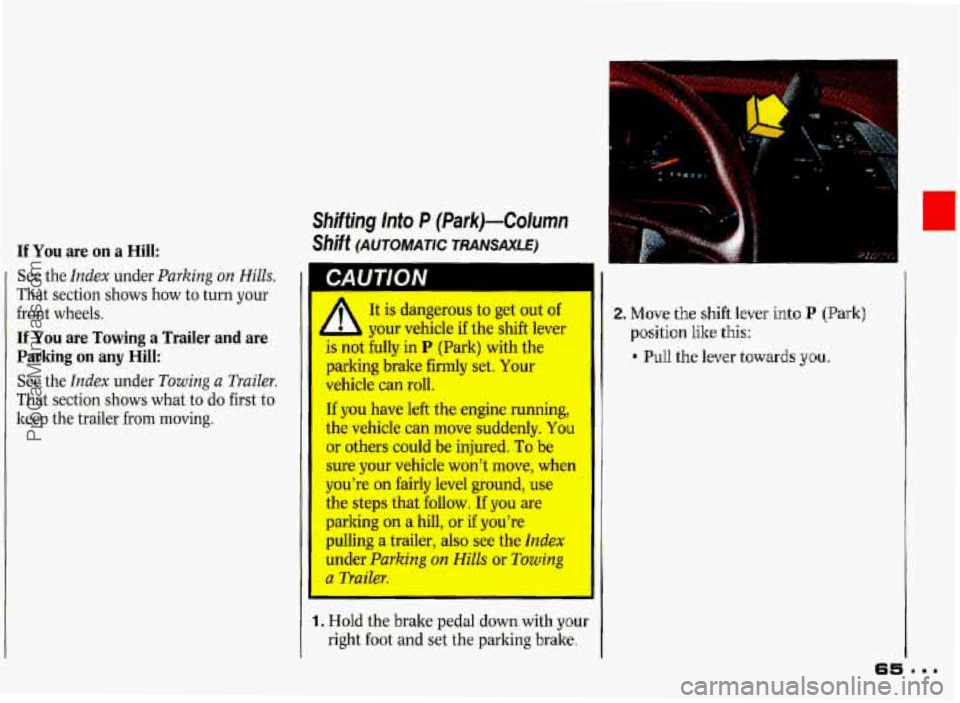
If You are on a Hill:
See the Index under Parking on Hills.
That section shows how to turn your
front wheels.
If You are Towing a Trailer and are
Parking on any Hill:
See the Index under Towing a Trailer.
That section shows what to do first to
keep the trailer from moving.
Shifting Info P (Park)-Colurnn
Shift (AUTOMATIC JRANSAXLE)
I CAUTION
A
It is dangerous to get out of
your vehicle if the shift lever
is not fully in P (Park) with the
parking brake firmly set. Your
vehicle can roll.
If you have left the engine running,
the vehicle can move suddenly.
You
or others could be injured. To be
sure your vehicle won’t move, when
you’re on fairly level ground, use
the steps that follow. If you are
pulling
a trailer, also see the Index
under Parking on Hills or Towing
a Trailer.
I parking on a hill, or if you’re
1. Hold the brake pedal down with your
right foot and set the parking brake.
I
2. Move the shiH lever into P (Park)
Pull the lever towards you.
position like this:
n
ProCarManuals.com
Page 67 of 338
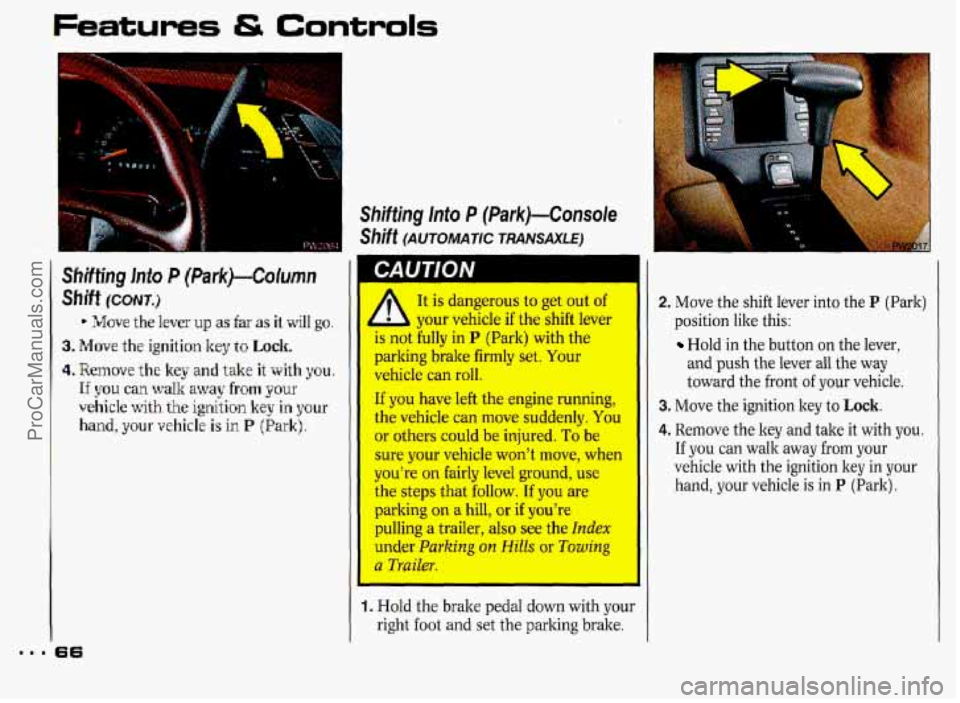
Features Controls
-
Shifting Into P (Park)-CoJumn
Shift (CONJ.)
* Move the lever up as far as it will go.
3. Move the ignition key to Lock.
4. Remove the key and take it with you.
If you can walk away from your
vehicle with the igniti'on key in your
hand, your vehicle is in P [Park).
Shifting lnto P (Park)-Console
Shift (AUTOMATIC TRANSAXLE)
GAUTIUN
It is dangerous to get out of
your vehicle
if the shift lever
is not fully in P (Park) with the
parking brake firmly set. Your
vehicle can roll.
If you have left the engine running,
the vehicle can move suddenly.
You
or others could be injured. To be
sure your vehicle won't move, when
you're on fairly level ground, use
the steps that follow. If
you are
parking
on a hill, or if you're
pulling
a trailer, also see the Index
under Parking on Hills or Towing
a Trailer.
2. Move the shift lever into the P (Park)
position like this:
Hold in the button on the lever,
and push the lever all the way
toward the front of your vehicle.
3. Move the ignition key to Lock.
4. Remove the key and take it with you.
If you can walk away from your
vehicle with the ignition key
in your
hand, your vehicle is in
P (Park).
I. Hold the brake pedal down with your
right foot and set the parking brake.
ProCarManuals.com
Page 70 of 338
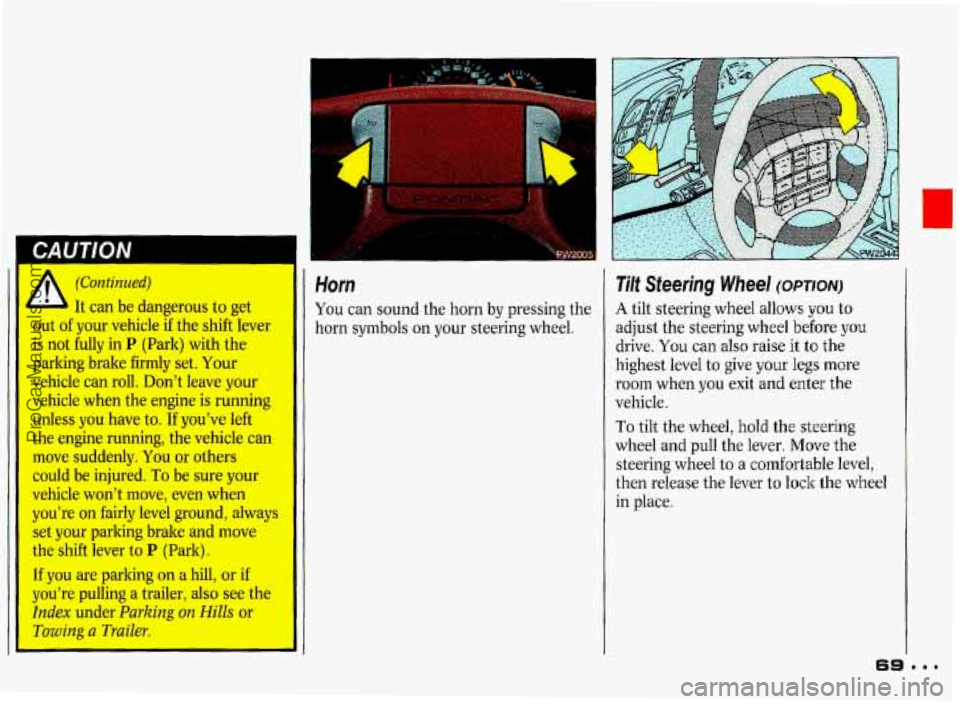
(Continued)
is not hlly in P (Park) with the
parking brake firmly set. Your
vehicle can roll. Don’t leave pur
vehicle when the engine is running
unless you have to. If you’ve left
the engine running, the vehicle can
move suddenly. You or others
could be injured. To be sure your
vehicle
won’t move, even when
you’re on fairly level ground, always
set your parking brake and move
the
shift lever to P (Park).
If you are parking on a hill, or if
you’re pulling a trailer, also see the
In&x under Parking on Hills or
Towing a Tnzileu.
.- i ,- - . I.
Horn
You can sound the horn by pressing the
horn symbols on your steering wheel.
Tilt Steering Wheel (omow
A tilt steering wheel allows you to
adjust the steering wheel before
you
drive. You can also raise it to the
highest level
to give your legs more
room when you exit and enter the
vehicle.
To tilt the wheel, hold the steering
wheel and pull the lever.
Move the
steering wheel to
a comfortable level,
then release the lever to
lock the wheel
in place.
ProCarManuals.com
Page 108 of 338
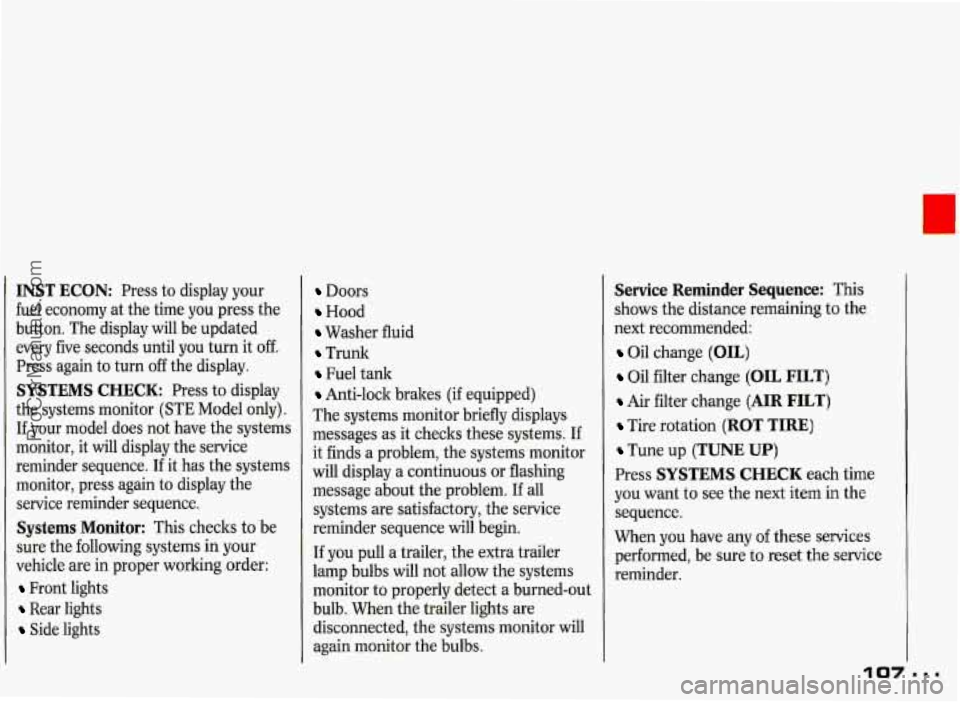
INST ECON: Press to display your
fuel economy at the time you press the
button. The display will be updated
every five seconds until you turn it off.
Press again to turn off the display.
SYSTEMS CHECK: Press to display
the systems monitor
(STE Model only).
If your model does not have the systems
monitor, it will display the sewice
reminder sequence.
If it has the systems
monitor, press again to display the
service reminder sequence.
Systems Monitor: This checks to be
sure the following systems in your
vehicle are in proper working order:
Front lights
Rear lights
Side lights
Doors
Hood
Washer fluid
Trunk
Fuel tank
Anti-lock brakes (if equipped)
The systems monitor briefly displays
messages as it checks these systems. If
it finds a problem, the systems monitor
will display a continuous
or flashing
message about the problem. If all
systems are satisfactory, the service
reminder sequence will begin.
If you pull a trailer, the extra trailer
lamp bulbs will not allow the systems
monitor to properly detect a burned-out
bulb. When the trailer lights are
disconnected, the systems monitor will
again monitor the bulbs.
Service Reminder Sequence: This
shows the distance remaining to the
next recommended:
Oil change (OIL)
Oil filter change (OIL FILT)
Air filter change (AIR FILT)
Tire rotation (ROT TIRE)
Tune up (TUNE UP)
Press SYSTEMS CHECK each time
you want to see the next item in the
sequence.
When you have any of these services
performed, be sure to reset the service
reminder.
ProCarManuals.com
Page 138 of 338
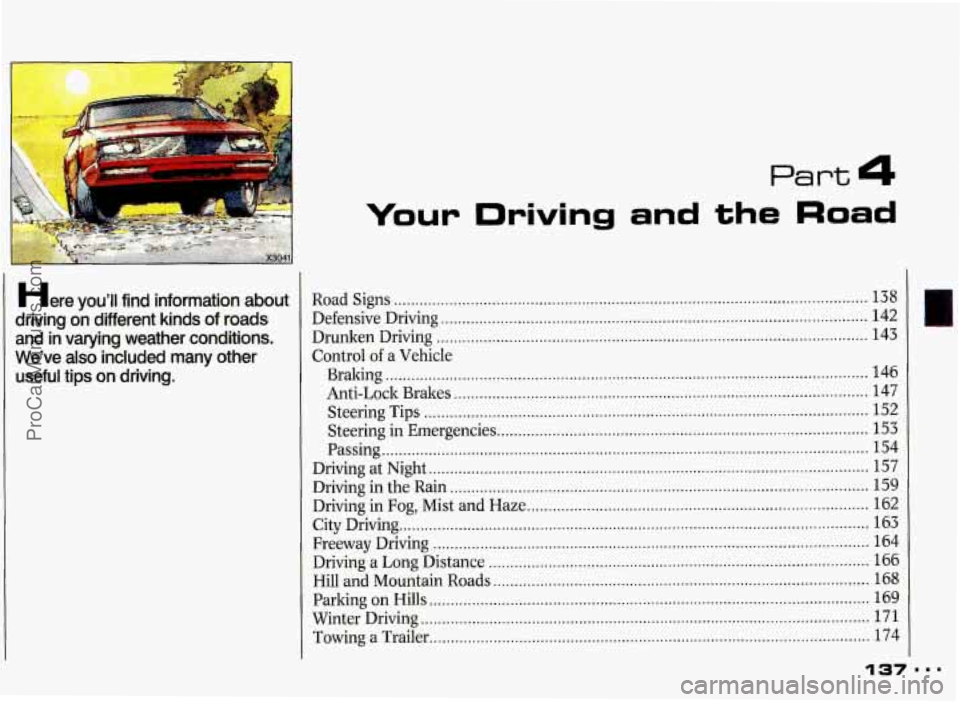
Part 4
Here you'^ find information about
driving
on different kinds of roads
and in varying weather conditions.
We've also included
many other
useful
tips on driving.
Your Driving and the Road
Road Signs ........................................................................\
....................... - ..... .........- 138
Defensive Driving . . . . . . . . . . . . . , . . . . . . . . . . . . . . . . . . . . . . . . . . . . . . , . . . . . . . . . . . . . . . . . . . . . . . . . . . . . . . . . . . . . . . . . . . . . . . . . . . . . . . 142
Drunken Driving
. . . . . . . . . . . , . . . . . . . . . . . . . . . . . . . . . . . . . , . . . . . . . . . . . . . . . . . . . . . . . . . . . . . . . . . . . . . . . . . . . . . . . . . . . . . . . . . . . . . . . 143
Braking
........................................................................\
......................................... 146
Anti-Lock Brakes
.... . . . . . .. . . . . . . . . . . . . . . . . . . . . . . . . . . . . . . . .. . . . . . . . ... . . . . . . . . . . . .. .. ... . ... . . ... ...... .. ... . . . .. 147
Steering
Tips ........................................................................\
................................ 152
Steering Emergencies. .... . . . . . . . . . . . . . . . . . . . . . . . . . . . . . . . . . . . . . . . . . . . . . . . . .. . .... ... . . . . . . . . .. . ...... . . ... . . 153
Passing.. . . . . . , . . . . . , . . . . . . . . . . . . . . . . . . . . . . . . . . . . . . . . . . . . . . . . . . . . . . . . . . . , . . . . . . . . . . . . . . . . . . . . . . . . . . . . . . . . . . . . . . . -. . . . . . . . 154
Driving at Night
.. . . . . . . . . . . . . . . . . . . . . . . . . . . . . . . . . . . . . . . . . . . . . . . . . . . . . . . . . . . . . . . . . . . . . . .. . .... . . . . . . . . . . . . . . . .. .. ... . .. 157
Driving in the Rain
. .. . . . . . . . . . . . . . . . . . . . . . . . . . . . . . . . . . . . . . . .. . . . . . . . . . . . . . . . . . . .. . . . . .. . .. .. . .... . . . . . . , .. .... . .... . 159
Driving Fog, Mist and Haze ............................................ ..................... ,. . ............ 162
City Drlvmg.. . . . .. . . . . . . . . . . . . . . . . . . . . . . . . . . . , . . . . . . . . . . . . . . . . . . . . . . . . . . . . . . . . . . . . .. . . . . . . . . . . . . . . . . . . . . . . . . . . . . . . . . . . . . . 163
Freeway Driving . . . . . . . . . . . . . .. . . . . . . . . . . . . . . . . . . . . . . . . . . . . . . . . . . . . . . . . . . . . . . .. . . . . . . . . . . . . . . . . . . . . . . .. . . . . . . . . . . . . . . . 164
Driving a Long Distance
........................................................................\
................. 166
Hill and Mountain Roads
........................................................................\
................ 168
Parlcing on Hills .... ..... . ..... . .. ... ... . .. ... .. . .. ....... ... . . ... , . . .. . ... .... . . ... . . . ... . ... . . . ... . ... . .... .. . ..... . . 169
Winter Driving .. . . . . . .. . . . . . . . . . . . . . . . . . . . . . . . . . . . . . . . . . . . . . . . . . . . . . . . . . . ... . . . ... . . .. . ..... ... . . . . . . ,. .. . . ... .. . . . .. .. 171
Towing a Trailer..
. . . . . . . . . . . . . . . . . . . . . . . . . . . . . . . . . . . . . . . . . . . . . . . . . . . . . . . . . . . . . . .. . . . . . . . . . . . . . . . . . . . . . . . . . . . . . -. . . . . . . 174
Control
of a Vehicle
..
.. .
..
ProCarManuals.com
Page 175 of 338
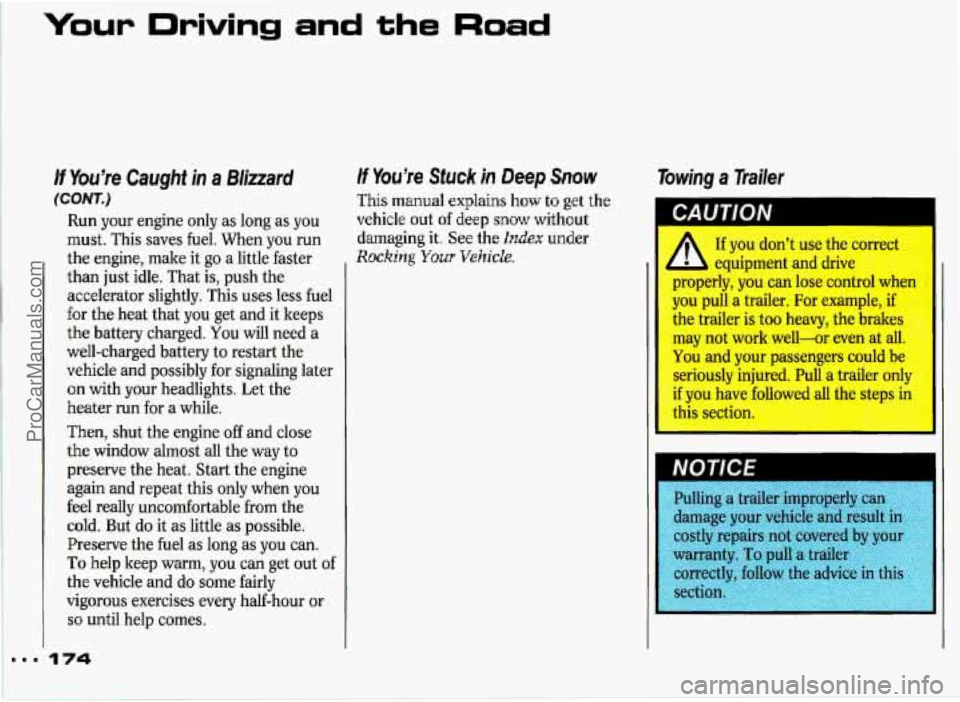
Your Driving and the Road
If You’re Caught in a Blizzard
(COW.)
Run your engine only as long as you
must. This saves fuel. When you run
the engine, make it go a little faster
than just idle. That is, push the
accelerator slightly. This uses less fuel
for the heat that you get and it keeps
the battery charged.
You will need a
well-charged battery to restart the
vehicle and possibly for signaling later
on with your headlights. Let the
heater run for
a while.
Then, shut the engine
off and close
the window almost all the way to
preserve the heat. Start the engine
again and repeat this only when you
feel really uncomfortable from the
cold. But do it as little as possible.
Preserve the fuel as long as you can.
To help keep warm, you can get out of
the vehicle and do some fairly
vigorous exercises every half-hour or
so until help comes.
..a 174
If You’re Stuck h Deep Snow
This manual explains how to get the
vehicle out
of deep snow without
damaging it. See the index under
Rocking Your Vehicle.
Towing a Trailer
CAUTlON
f
A
If you don’t use the correct
equipment and drive
properly, you can lose control whf
you pull a trailer. For example, if
the trailer is too heavy, the brakes
may not work well-or even at all
You and your passengers could be
seriously injured. Pull a trailer only
if you have followed all the steps in
this section.
Pulling a trailer improperly can
damage your vehicle and result
in
costly repairs not covered by your
warranty.
To pull a trailer
correctly, follow the advice
in this
section.
ProCarManuals.com
Page 176 of 338
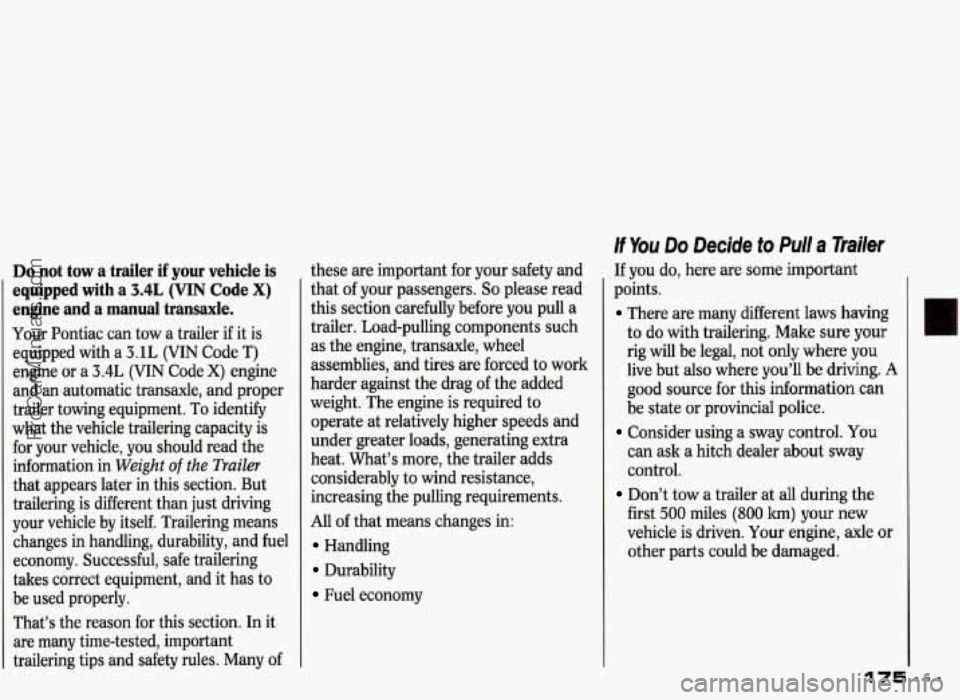
Do not tow a trailer if your vehicle is
equipped with a 3.4L (VIN Code X)
engine and a manual transaxle.
Your Pontiac can tow a trailer if it is
equipped with a
3.1L (VIN Code T)
engine or a 3.4L (VIN Code X) engine
and an automatic transaxle, and proper
trailer towing equipment.
To identify
what the vehicle trailering capacity is
for your vehicle, you should read the
information in
Weight of the Trailer
that appears later in this section. But
trailering is different than just driving
your vehicle by itself. Trailering means
changes in handling, durability, and fuel
economy. Successful, safe trailering
takes correct equipment, and it has to
be used properly.
That’s the reason for this section. In it
are many time-tested, important
trailering tips and safety rules. Many of these
are important
for your safety and
that of your passengers.
So please read
this section carefully before you pull a
trailer. Load-pulling components such
as the engine, transaxle, wheel
assemblies, and tires are forced to work
harder against the drag of the added
weight. The engine is required to
operate at relatively higher speeds and
under greater loads, generating extra
heat. What’s more, the trailer adds
considerably to wind resistance,
increasing the pulling requirements.
All of that means changes in:
Handling
Durability
Fuel economy
If You Do Decide to Pull a Trailer
If you do, here are some important
points.
There are many different laws having
to do with trailering. Make
sure your
rig will be legal, not
only where you
live but also where you’ll be driving. A
good source for this information can
be state or provincial police.
Consider using a sway control. You
can ask a hitch dealer about sway
control.
Don’t tow a trailer at all during the
first
500 miles (800 km) your new
vehicle is driven. Your engine, axle or
other parts could be damaged.
ProCarManuals.com
Page 177 of 338
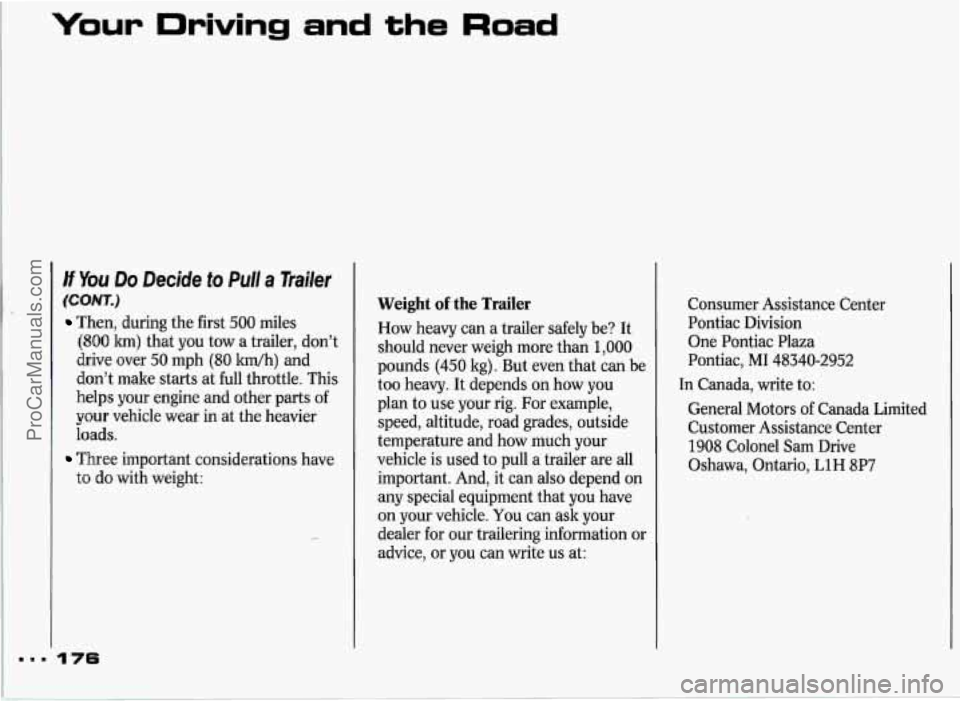
Your Driving and the Road
H You Do Decide to Pull a Trailer
(CONT.)
Then, during the first 500 miles
(800 krn) that you tow a trailer, don’t
drive over
50 mph (80 km/h) and
don’t make starts at full throttle.
This
helps your engine and other parts of
your vehicle wear in at the heavier
loads.
Three important considerations have
to do with weight:
Weight of the Trailer
How heavy can a trailer safely be? It
should never weigh more than
1,000
pounds (450 kg). But even that can be
too heavy. It depends
on how you
plan to use your rig. For example,
speed, altitude, road grades, outside
temperature and how much your
vehicle is used to pull a trailer are all
important. And, it can also depend
on
any special equipment that you have
on your vehicle.
You can ask your
dealer for our trailering information or
advice, or you can write
us at:
Consumer Assistance Center
Pontiac Division
One Pontiac Plaza
Pontiac, MI 48340-2952
In Canada, write to:
General Motors of Canada Limited
Customer Assistance Center
1908 Colonel Sam Drive
Oshawa, Ontario,
L1H 8P7
ProCarManuals.com